What Makes Amy Lee (Evanescence) Great?
Amy Lee, to me, is an artist that embodies vulnerability, strength, fragility and power. But how does she manage to incorporate these seemingly contradictory qualities? What makes Amy Lee great.
Technique
Tone
Amy Lee’s tone is smooth, warm and distinctive. The first thing I wanted to show you was how her voice has developed throughout the years. She has maintained the essence of her tone, yet it has matured. The first clip we will listen to is Bring Me To Life; Evanescence's first big hit when she was just 21 -years old (2003) and then a clip from the more recent Synthesis album (2017).
In the younger years, her tone has a lot of higher frequencies in it. Her voice sounds lighter, more fragile, more piercing in those high belts. It was this sound that first drew me to her. It embodies my unsure and emotional teenage experience.
As she gets older, her voice warms, and this is both due to her voice maturing and a slight change in technique. She is more relaxed and doesn’t push as much but maintains a direct power. I’m not sure if she has done conscious work on her voice or just her becoming more in tune with her voice over the years, but I love how her voice has grown while maintaining her original character.
Range
Amy has a big range with the ability to sing with control in songs from an E3 to C6 . Here is what the lower end sounds like.
She has control over her midrange with a soaring belt that can be a little chest dominant but generally mixed. She sometimes uses a sorrowful light mix or even occasionally a breathy head voice. She does whatever the emotion needs. You can hear a few of these different approaches on her D5 here
I like the one where she moves from a light breathy head voice into a fuller mix. Difficult. My favourite part of her voice is when she uses a full head voice; her voice is clear, bright, and resonant. It rings. You can hear her top notes in Lacrymosa (2017 Synthesis Album)
Pretty impressive.
Although she does vary the tone and how she uses registers for expression, she can ascend seamlessly through the registers giving the feel of one complete voice rather than different pieces. It moves from dark at the bottom and gradually lightens to a clear ring at the top of her range. For me, this is the ideal to give different tonal qualities throughout the registers or blend them at will.
Vowels and Consonants
Generally, vowels are the sung part of the note, and consonants are the stoppers. Amy sings on her vowels, giving it a very “sung” sound with a flowing legato feel and uses very soft consonants, sometimes even making them quite sibilant. You can really hear it in this version of Bring Me To Life (2017)
She often moves vowels towards an “ah” vowel with a wide mouth adding to her direct sound on her belts, although as her vocal style has developed, she rounds this shape more, resulting in a warmer sound. Although this is a little divisive in the vocal coach community, these wider vowel shapes add to her emotional expression. It echoes the mouth shapes people generally make when emotionally screaming.
Further Technique
We talked about Amy’s unique tone, but how does she produce it? Of course, it is partially down to the general makeup of her instrument, the size and shape of her vocal cords and vocal tract. However, we can all manipulate the shape and size of our vocal tract to a certain extent. It is pretty impossible to tell precisely without doing an MRI scan while singing.
Twang, Tongue and Larynx - It sounds like has good vocal cord closure on her belted notes and is using twang. People often confuse twang with nasality, when the air travels through the nose. Twang is narrowing just above the vocal cords. Think of a water hose: if you narrow the nozzle where the water comes out, the water will shoot out faster. For the vocal cords, this means more output for less input, the vocal cords can do less work, but the sound that comes through the narrow ‘hose’ will be focused and powerful. It gives the voice a vibrant, crystal clear sound and can help singers reach higher and lower notes with more power and volume. I’m not sure if this ringing resonance is something she is doing purposefully, as she has a lot of this sound in her speaking voice. With some singers, other parts of the vocal tract can also narrow when using twang, for example, the tongue sometimes raises and often the larynx rises. In her early career, I think she is doing this, giving it that more direct sound. However, in more recent live clips, it sounds like she has a lower larynx position and a more relaxed tongue.
Although it is interesting to note that twang is technically a narrowing of the pharynx, it is important to note that it won’t feel like narrowing. You are more likely to feel the feeling resonance at the front of your face. If you do go for the idea of narrowing, you are likely to squeeze and get in the way of your singing voice. When things are working well with the voice, it will feel easy and relaxed.
Breath Support - Amy Lee has great breath support. This means that she has a relaxed in-breath and a slow relaxed exhale. Allowing her to sing unwavering long notes on her exhale and maintain a full tone. You can hear those well supported long notes here (Lacramosa 2017)
Piano - And of course, she is a great piano player and wanted to originally be a classical composer. Her love for classical music and her in-depth knowledge comes through in her writing, drawing inspiration from some of the worlds greatest classical composers
Emotional Expression
Amy Lee is a master at expressing emotion, and you all know, I just love singers that can connect emotionally. Here are a few techniques that contribute to this expressive sound.
Sob & Cry
There are two particular terms used in singing that come from the Estill singing technique. Estill has some useful methods, and I think these sounds describe Amy’s style very well - “sob” and “cry”.
Sob is a soft and dark quality associated with the sobbing cry of an adult who mourns. Sob is produced on a lowered larynx and thinned vocal folds and releases compression and constriction. Technically this can be an excellent nuance to go to during a highly emotional song to keep tension check, especially if you are dealing with many strong high mixes.
Cry is like sob with similar emotional connections yet has a higher larynx and can be accompanied by a raised tongue position. Both of these sounds echo the sound we make when we cry. It adds movement through the note and an ebb and flow of dynamic. This is interesting because she did use a lot of cry sounds at the start of her career when she sang with a higher larynx and arched her tongue more often.
Nowadays, she mixes it up, switching between the darker quality of sob and the emotional tension of cry. This mix and match of sound adds to the emotional variety and is less taxing for the voice by continually going back to that release sob sound. Plus, it just sounds wonderful.
Vibrato
Amy Lee paints emotion with her vibrato. Everything she sings connects with emotion, echoing how our voices naturally react to emotional situations. For example, she often doesn’t use vibrato on her belted notes, making it feel more primal like she is calling out or screaming.
She will sometimes add vibrato at the end of particularly long, held notes to add intensity and finish off the end as if it is a final push of emotion. Or soften the edge of an intense note, bringing the audience back to a more emotionally controlled, safe place in the voice.
She uses vibrato on lower emotional, fragile passages, often combining it with a breathy tone to echo the wobble of a crying voice.
Dynamics, Phrasing and Articulation
Amy’s singing has constant movement, and her dynamics are just incredible. Each note eases in, swells, and falls back again, much like the bowing of a violin. This is partially down to her use of sob and cry.
Her dynamics show in her phrasing, with each phrase having a dynamic swell giving the feeling of waves of emotion. Her writing is dramatic and fluid, following dynamic arcs and combining them with sudden dynamic changes in the orchestration. I can only describe hearing her dynamics as like watching the ocean from the shore; sometimes they are huge rolling waves that crash ferociously against the rock and at other times a gentle rocking sea that laps against the sand, but either way, continually moving.
Her articulation is generally smooth, and instead of using staccato, she often opts for broken up accented notes. You can hear that here in a clip from the new Evanescence album
Social Context
I remember when the first Evanescence album “Fallen” came out. I was browsing HMV looking for something that might be interesting when a shop assistant came up and put it in my hand and told me I had to listen. I had looked at the male-orientated rock genre before and enjoyed the rebellious spirit, but none of the artists had spoken to me directly. To a young woman who desperately tried to hide her emotional nature, it was a breath of fresh air. Amy expressed her emotions so freely while maintaining her strength. Her emotions were her strength. She embodied qualities that had seemed opposite: vulnerability, strength, fragility and power. Her music allowed me and other young people to understand that perhaps these qualities were more aligned than we had first thought, providing an outlet for the big emotions.
But it doesn’t end there. Throughout the years as I have grown, the music of Amy Lee and Evanescence has matured; taking me through the heartbreaks and social anxiety of my 20s with aching violins and violent drums and guitars towards today’s broader world issues with the newest Evanescence album that came out this week (April 2021). Amy Lees work has paved the way for many young women in rock, in fact, she actively champions women in rock. This has helped allow a generation of young women to enter the music industry without having to subscribe to the ideals that much of the industry expects of women. Allowing people to harness their own creative energy without compromise. I think that is a wonderful gift she has given us all.


